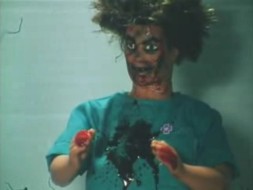|
Newest Reviews:
New Movies -
The Tunnel
V/H/S
The Tall Man
Mama Africa
Detention
Brake
Ted
Tomboy
Brownian Movement
Last Ride
[Rec]³: Genesis
Hara-Kiri: Death of a Samurai
Indie Game: The Movie
Abraham Lincoln: Vampire Hunter
Old Movies -
Touki Bouki: The Journey of the Hyena
Drums Along the Mohawk
The Chase
The Heiress
Show
People
The Strange Affair of Uncle Harry
Pitfall
Driftwood
Miracle Mile
The Great Flamarion
Dark Habits
Archives -
Recap: 2000,
2001, 2002,
2003, 2004
, 2005, 2006,
2007 , 2008
, 2009 ,
2010 , 2011 ,
2012
All reviews alphabetically
All reviews by star rating
All reviews by release year
Masterpieces
Screening Log
Links
FAQ
E-mail me
HOME
| |
The Psychotic Odyssey of Richard Chase (Carey Burtt,
1999)
 The true story of a
Sacramento-based serial killer is relayed via an unconventional medium in Carey
Burtt’s unsettling 16mm short work The
Psychotic Odyssey of Richard Chase. As a distorted narrator’s voice intones,
the disturbing biographical details of Chase’s life are dispassionately relayed.
Tracing Chase’s development from troubled tot to full-blown sociopath, Burtt’s
movie visualizes the killer’s heinous acts with a collection of action figures,
crude drawings, and found footage. The clear stylistic forbearer here is Todd
Haynes’ seminal Superstar: The Karen
Carpenter Story. Each of these films uses toys to fill out its cast, at once
distancing the audience from the narrative and daring us to let our guard down.
In both, the campy novelty of the approach quickly gives way to something more
genuine. As Psychotic Odyssey
unfolds, the utterly alien nature of Chase’s behavior supersedes the dolls or
the narration as the most effective distancing effect here. This subject simply
is too far gone to be adequately explained. It’s to Burtt’s credit that he dares
not try. As the depths of Chase’s depravity become clear, any laughs prompted by
the novelty of Burtt’s approach are likely to get stuck in your throat. The true story of a
Sacramento-based serial killer is relayed via an unconventional medium in Carey
Burtt’s unsettling 16mm short work The
Psychotic Odyssey of Richard Chase. As a distorted narrator’s voice intones,
the disturbing biographical details of Chase’s life are dispassionately relayed.
Tracing Chase’s development from troubled tot to full-blown sociopath, Burtt’s
movie visualizes the killer’s heinous acts with a collection of action figures,
crude drawings, and found footage. The clear stylistic forbearer here is Todd
Haynes’ seminal Superstar: The Karen
Carpenter Story. Each of these films uses toys to fill out its cast, at once
distancing the audience from the narrative and daring us to let our guard down.
In both, the campy novelty of the approach quickly gives way to something more
genuine. As Psychotic Odyssey
unfolds, the utterly alien nature of Chase’s behavior supersedes the dolls or
the narration as the most effective distancing effect here. This subject simply
is too far gone to be adequately explained. It’s to Burtt’s credit that he dares
not try. As the depths of Chase’s depravity become clear, any laughs prompted by
the novelty of Burtt’s approach are likely to get stuck in your throat.
Despite the abstraction caused by
the doll actors, Psychotic Odyssey
grows increasingly gruesome as Chase begins to eat animals and eventually turns
his attention to human victims. This film’s extremely abstracted violence
arguably becomes, in a way, as unsettling as any attempt at a more realistic
representation might. It is impressive that Burtt creates such a sense of dread
while wielding such a limited palette. Paper cutouts are used as stand-ins for
Chase’s perceived oppressors. An anatomical “visible man” model is used to
visualize his hypochondriac fears. With primitive but expressive lighting, Burtt
imbues his simple dioramas with real atmosphere. The crude crayon drawings and
cardboard sets become more than adequate in this context. They drive home the
impossibility of doing the film’s subject full justice in this medium, and
always remind the audience that in viewing cinema, we do not view truth. The
chilling net effect of this six minute long descent into madness is greater than
the sum of its parts. The home-made production values of
Psychotic Odyssey domesticates
Chase’s insanity, associating it with familiar, typically benign objects,
ultimately making it that much harder to shake off or compartmentalize.
66
Jeremy Heilman
04.28.09
|